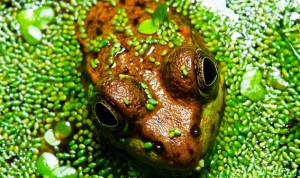- Home
- Tutorial
- Resource Guides
- Focus Areas
- LSF Programs
-
Professional
Development - Review Process
-
A project of LSF

Search for Resources
Mating on their Minds: Frogs and Salamanders
Early April 2025Top R4R Picks
Resources for extending the learning
-
Mr. BullfrogElementary, Middle
-
A Guide to Growing a School Butterfly GardenElementary, Middle, Secondary
-
The Great Monarch MigrationElementary, Middle
-
Salamander CrossingElementary, Middle
-
The Monarch ButterflyElementary
-
-
Monarch Butterfly: Royal MailElementary, Middle
-
-
Amphibial Pursuits FrogWatch Teachers’ GuideMiddle, Secondary
-
How Do Insects Survive the Winter?Elementary, Middle
-
Magic School Bus- Hops HomeElementary, Middle
-
FrogsElementary
-
Rick Mercer: Black Bear Tagging in Algonquin ParkMiddle, Secondary
-
Frogs: The Thin Green LineMiddle, Secondary
-
Sorting through SpringElementary
Featured event: “Froggy went a courtin’...”
Just as the September cicadas were a harbinger of fall, nothing says spring to me more than the calling of frogs in their eternal mating dance. A few weeks ago (and perhaps still in some places), some were just the frogsicles of Late November, but now they have thawed, and have mating on their little minds.
Only the males will call, attracting females and in some cases establishing territory. This will begin when the air temperatures at night warm up to at least 8oC. The first few may have begun calling at the end of March in the deep southwest of Ontario, but April or May is generally their months to shine in many parts of Canada. Calls are most common from dusk to full dark, but some species will call during the day. Look for mild, damp, still conditions after or even during a light rain.
Fertilization is external. The male clasps the female from behind and mixes sperm with the eggs as they come out of her body. The fertilized eggs of early spring frogs sink well below the surface, where they are insulated from late, hard frosts and ice film.
Below is information on a few commonly occurring frogs, in rough order of April appearance.
When looking, remember that some of these frogs are no bigger than a bumblebee. Look for their throat sacs as they call. For more information on these and other frogs and toads, and to hear their calls, visit the FrogWatch site (you will have to register; they also have some great K-6 lessons on frogs) and search.

|
Frog |
Location |
Call |
Look for |
|
Western Chorus Frog |
Almost any fishless pond; prefer grassy/ shrubby swamp areas. |
Rising trill; sounds like a fingernail drawn across a comb. |
On surface in floating plant debris; very hard to see. |
|
Spring Peeper |
Wide range of ponds, vernal pools; most common near brushy thickets |
Loud, high-pitched peep, rising at end. |
On vegetation just above water. |
|
Wood Frog |
Wooded wetlands and swamps; vernal pools. |
Short chuckle, like ducks quacking. |
On surface in floating plant debris. |
|
American Toad |
Shallow ponds, streams &roadside ditches |
Long, monotone trill; different toads have different notes. |
In aquatic and emergent vegetation |
|
Leopard Frog |
Relatively permanent, fishless ponds |
Rattling snore and guttural chucks; like wet hands rubbing a balloon. |
Surface, mostly submerged. |
Again, consider joining FrogWatch, and add to our information about these amphibians.
|
In this outdoor activity, Frog Spawn Relay, students will act out some of the stages in the life cycle of a frog and then participate in a relay to demonstrate the metamorphic process of the frog’s life cycle. |
 INVASIVE ALERT
INVASIVE ALERT
While exploring marshes for amphibians keep your ears open for the distinctive jug o rum call of the American Bullfrog. If you have ever eaten frog legs, they likely came from this massive creature which just happens to be listed internationally as one of the world’s top 100 invasive species. Bullfrogs will eat just about anything they can fit in their mouths including other frogs and tadpoles. This voracious appetite can lead to population declines in native species which is exactly what happened in British Columbia following the introduction of the bullfrog several decades ago. It should be pointed out that the American Bullfrog is native in many parts (scroll down) of eastern Canada and some of these populations are actually in trouble due to over harvesting and habitat loss.
So what can you do to help? One of the best ways to prevent the spread of many non-native species is to ensure we don’t move these organisms into other sensitive habitats with our outdoor activities. So go outside and enjoy catching and releasing tadpoles, just make sure you put them back where you found them.
Other Happenings:
- Salamanders also have sex on their minds, and often travel some distance to mate in vernal pools. The most commonly observed species are the (Yellow) Spotted Salamander, the Blue-spotted Salamander and the Red-spotted (Eastern) Newt. By using these temporary ponds, salamanders avoid predation of their eggs and young by fish and turtles, but must breed early enough for their larvae to transform before the ponds dry up. Mild, rainy nights above 8oC are a good time to look for them along roads passing through swampy woodlands. Take care that you don’t run over any. In some cases, underpasses have been built so the salamanders can avoid traffic.
Salamander Crossing challenges students to create a way to get salamanders safely from one side of the road to the other. Students construct a model of a salamander migration area with a road passing through it and design a crossing to get the salamanders safely to their breeding grounds.
- Any early, fairly large mosquitoes that you see are from the Genus Culex, and have overwintered as adults (scroll down for photo).
- Cold weather hasn't delayed the Monarch Butterfly migration, with many clustering along the Gulf coast and beginning to move up the eastern seaboard, through Texas and into the inner South. These are the same butterflies that left the North last fall, and they have now mated, but they won’t make it back up here. They will stop and lay their eggs, mostly in Texas. They will largely keep pace with milkweed, which has bloomed through Texas north to the Illnois border and into Louisiana and across to the Carolinas.
- How many Monarchs to expect this year is a significant question. The population was up 144% in 18-19 over 17-18’s annual winter count, and at a level that, if sustained, is the target for Monarch recovery. However, the numbers declined by 67% over the following two years, there have been declines in six of the previous ten years, and a general decadal decline over 30 years, a worrying trend. This year, while significantly higher than last year's extremely low numbers, they are still well within the decadal decline. This general decline has been linked to both deforestation of the overwintering habitat in Mexico, drought conditions, and a significant decline of milkweed (scroll down) and breeding habitat in general (147 million acres in the U.S. since 1992) resulting in part from an increase in the use of certain herbicides. Everything is connected! Stay tuned to Journey North for weekly updates, and sign up to report your first Monarchs.
- Woolly Bear caterpillars are again briefly seen, shaking off the effects of winter hibernation (and perhaps a late frost) before pupating and emerging as Isabella Moths.
- Near birch or aspen woods, look for The Infant, a day-flying moth that appears orange at a distance.
- Those other bears, the Black ones, are coming out of their winter dens – first males, then females with yearlings or no cubs, and finally females with cubs. Denning periods are a good time to measure and tag both adults and cubs – check out Rick Mercer’s experience doing winter bear research with the OMNR. Spring bears are almost entirely vegetarian, starting on Balsam Poplar buds and going on to new aspen leaves, grass and dandelions. Bears won’t gain back all the weight lost during the winter until summer berry season.
- Look for River Otters active on the remaining ice margins beside open water. They will bring prey up onto the ice to eat, and are highly visible against the snow and ice.
- Groundhogs (Woodchucks) finally emerge from hibernation, if they haven’t already. How did their Groundhog Day prediction (Early February) turn out in your region?
- Ruffed Grouse males will be drumming throughout April, trying, of course, to interest a female. The sound is at a fairly low register, and may sound like someone in the distance trying to start a balky motorbike (scroll down). The sound is not from the wings hitting the log, but rather by air rushing into the vacuum created when the wings end their downward stroke and begin the upward one.
- Waterfowl numbers are normally at their peak early in the month, as those returning for the summer rub wings with those just passing through. Look for Common Loon, Horned Grebe, Red-necked Grebe, Sandhill Cranes and Double-crested Cormorants coming in early. Ospreys should also be arriving, and beginning to nest. We spotted a pair on our lake on March 26th one year.
- April is the best month to hear Barred Owls (includes call).
- “April showers bring May flowers.” April is generally thought of as a rainy month, but in many parts of the country May and June are on average much rainier. Find out how rainy April generally is in your region, and see if it holds true this year.
- The Southern Triangle begins to rise in the eastern morning sky, and Orion (scroll down) is low to the west, reclining as if tired of his winter-long domination, and finally taking his leave with the rest of the cold weather.

